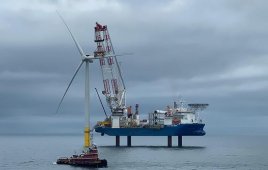 America always does the right thing, but only after trying all the wrong things. Winston Churchill said something like that and he’s right again, especially in view of Congress denying an extension of the Production Tax Credit. The credit will expire on December 31, 2012 along with the financial leverage it provides the wind industry. Hopefully, Congress will soon recognize its error and pass the recommended extension within the next few months.
America always does the right thing, but only after trying all the wrong things. Winston Churchill said something like that and he’s right again, especially in view of Congress denying an extension of the Production Tax Credit. The credit will expire on December 31, 2012 along with the financial leverage it provides the wind industry. Hopefully, Congress will soon recognize its error and pass the recommended extension within the next few months.
To encourage them, the wind industry should remind them of the PTC’s importance. For instance, it provides wind-farm operators with $0.022/kWh, a figure that makes more than wind farms profitable. It also helps pay farmers leases for use of their land – a few thousand dollars each month and enough to let people who want to stay on the land do so. It also pays municipalities so they can improve services and schools. The PTC has kept the wind industry healthy and growing, so much so that it now employs some 75,000 people, according to the American Wind Energy Association. Hence, it’s a jobs program with a successful and solid record. One projection has the industry employing 500,000 by 2030 if current growth rates continue.
More importantly, most jobs the wind industry produces are in manufacturing, the bedrock of the U.S. economy. Other jobs include construction work to prepare the land, pour foundations, and erect towers, more often than not, made with American steel. Furthermore, a recent survey showed that about ten permanent O&M jobs are created per 100 MW of wind plant. AWEA also calculates that each dollar of tax credit encourages investment of $3 to $4 from private equity. Consider also that we are witnessing a new dawn for the electric car so that when the recession ends, and it will, a growing nation will need more electric power.
At the moment, natural gas appears the fuel that generates the least expensive electricity. But what it will cost in five or ten years is anyone’s guess. In contrast to that uncertainty, the cost of fuel to drive a wind turbine is known at this instant as well as its price in 10 and 20 years. Furthermore, long-term power purchase agreements negotiated between wind farms and utilities stabilize the cost of power.
Critics say the tax credit is a handout and a subsidy. It is neither. Most industries, atomic, coal, and natural gas among them, take advantage of tax credits. The PTC, a similar mechanism, rewards production. AWEA stats suggest that oil and gas industries have received five times the PTC and nuclear gets ten times the rate.
The PTC has become a tipping point for the wind industry. If it does not pass by year’s end, the industry will likely soldier on but less vigorously than before. If it passes, as it should, the job engine we call the wind industry will power up.
Every generation of turbines has gotten more efficient and will continue along that trajectory so that in five to seven years, it is likely that the PTC will not be as needed and may be phased out. Will the atomic, coal, and natural-gas industries make similar statements?
Now would be a good time to contact your senators and representatives by phone and letter to encourage support for the PTC and keep fuel in the wind powered job engine.
Filed Under: Policy





I applaud the author for at least referencing the fact that the PTC was created in an attempt to provide equality for renewable enegy as it relates to the tax credits for fossil fuel. At the time (1991), the estimates for fossil fuel tax benefits were 2.5 cents per KWhr. We agreed to support 1.5 cents, but only on a production basis. I believe the coal oil and gas tax benefits are not dependent on production and are transferable. Our goal of parity was not achieved. Its important for everyone in the industry to understand this is not a special deal for wind. Every time you speak to a politician these facts should be conveyed.
Dale